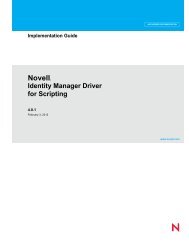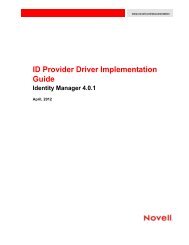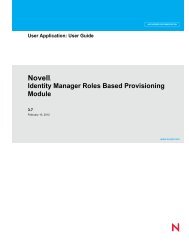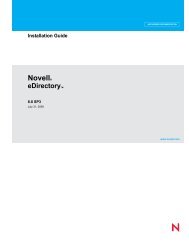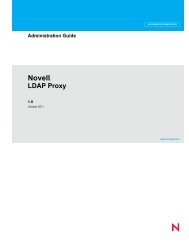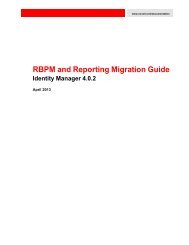Novell eDirectory 8.8 Troubleshooting Guide - NetIQ
Novell eDirectory 8.8 Troubleshooting Guide - NetIQ
Novell eDirectory 8.8 Troubleshooting Guide - NetIQ
Create successful ePaper yourself
Turn your PDF publications into a flip-book with our unique Google optimized e-Paper software.
16.6.2 Debugging Messages<br />
When the ndstrace screen is enabled, the information displayed is based on a default set of filters. If<br />
you want to view more or less than the default, you can manipulate the filters using the debugging<br />
message flags. The debugging messages help you determine the status of <strong>eDirectory</strong> and verify that<br />
everything is working well.<br />
novdocx (en) 22 June 2009<br />
Each <strong>eDirectory</strong> process has a set of debugging messages. To view the debugging messages on a<br />
particular process, use a plus sign (+) and the process name or option. To disable the display of a<br />
process, use a minus sign (-) and the process name or option. The following are some examples:<br />
Message<br />
set ndstrace = +SYNC<br />
set ndstrace = -SYNC<br />
set ndstrace = +SCHEMA<br />
Description<br />
Enables the synchronization messages.<br />
Disables the synchronization messages.<br />
Enables the schema messages.<br />
You can also combine the debugging message flags by using the Boolean operators & (which means<br />
AND) and | (which means OR). The syntax for controlling the debugging messages at the server<br />
console is as follows:<br />
set ndstrace = +trace_flag [trace_flag]<br />
or<br />
set ndstrace = +trace_flag> [&trace_flag]<br />
The following table describes the trace flags for the debugging messages. You can enter<br />
abbreviations for each of the trace flags.<br />
Trace Flag<br />
ABUF<br />
ALOC<br />
AREQ<br />
AUTH<br />
BASE<br />
BLNK<br />
CBUF<br />
CHNG<br />
COLL<br />
CONN<br />
Description<br />
Messages and information related to inbound and outbound packet<br />
buffers that contain data being received in conjunction with, or in<br />
response to, an <strong>eDirectory</strong> request.<br />
Messages to show the details of memory allocation.<br />
Messages related to inbound requests from other servers or clients.<br />
Messages and error reports relating to authentication.<br />
Debug error messages at the minimum debugging level.<br />
Backlink and inbound obituary messages and error reports.<br />
Messages related to outbound DS Client requests.<br />
Change cache messages.<br />
Status and error reports concerning an object’s update information<br />
when the update has been previously received.<br />
Messages that show information about the servers your server is trying<br />
to connect to, and about errors and timeouts that might be causing your<br />
server not to connect.<br />
86 <strong>Novell</strong> <strong>eDirectory</strong> <strong>8.8</strong> <strong>Troubleshooting</strong> <strong>Guide</strong>




